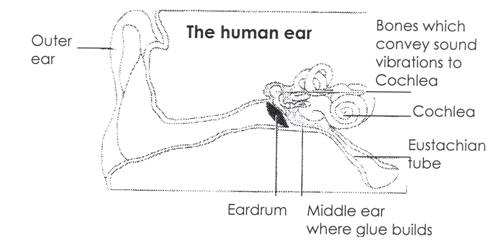As well as the visible, outer parts, each ear has middle and inner parts. Glue ear mainly affects the middle part. Each ear looks like this

Sounds travel into the ear along the ear canal and make the eardrum vibrate. These vibrations are passed along the three small bones inside the middle ear to the inner ear. (The middle ear is the space behind the eardrum.) The inner ear sends messages along the auditory nerve to the brain, allowing us to hear.
Near the bottom of each middle ear space is a tube called the eustachian tube. It connects the ear to the back of the nose. This tube lets air into the middle ear, keeping it aired and healthy. The air allows the eardrum to move freely.
How does glue ear happen
Glue ear happens when fluid collects in the middle ear space of one or both ears.
After a cold or infection in the throat or ear, one or both eustachian tubes can be blocked. When this happens, the air pressure inside the middle ear space drops. Fluid from the cells in the lining of the middle ear then fills up the middle ear space.
The fluid is often just a runny liquid. It may though become thicker, like glue. Hence the name "glue ear". When this happens, the eardrum cannot move as freely. It does not send vibrations into the inner ear easily. The child may then have a hearing problem.

